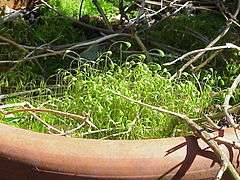Funariidae
| Funariidae | |
|---|---|
 | |
| Funaria hygrometrica | |
| Scientific classification | |
| Kingdom: | Plantae |
| Division: | Bryophyta |
| Class: | Bryopsida |
| Subclass: | Funariidae Ochyra |
| Orders | |
The Funariidae are a widespread group of mosses in class Bryopsida.[1] The majority of species belong to the genera Funaria (c. 200 species) and Physcomitrium (c. 80 species).
Classification
The Funariidae include three orders and five families, with around 350 species, most of which belong either to the genus Funaria or Physcomitrium.
- Order Encalyptales
- Family Bryobartramiaceae (1 species Bryobartramia novae-valesiae)
- Family Encalyptaceae (2 genera, 35 species)
- Order Funariales
- Family Disceliaceae (1 species Discelium nudum)
- Family Funariaceae (16 genera, ca. 300 species)
- Order Gigaspermales
- Family Gigaspermaceae (5 genera, 7 species)
Description
Species in the subclass Funariidae typically live on or near the ground. Their stems typically have a central strand differentiated from the surrounding cells. The peristome teeth of their sporangia are arthrodontous, diplolepidous, and opposite.[2]
They are acrocarpous, producing their archegonia at the upper tips of the stem, and hence sporophyte stalks arise from the tip of the stem as well. The capsule of the order Funariales has a well-defined ring of cells called an annulus. When these cells die, their walls rupture, allowing the sporangium lid to fall off, and revealing the peristome.[1] In the other two orders, the annulus is not differentiated. In the Gigaspermales, the capsule is not raised above the plant on a stalk, but remains hidden from view among the leaves. In the Encalyptales, the capsule is jacketed inside the calyptra long after it is raised above the plant, giving the appearance of a tiny mushroom.
Gallery
- Cross section of stem, showing the central strand.
- A single leaf, consisting of a single sheet of cells.
- Gametophytes of Funaria hygrometrica with the sporophyte generation emerging from the tips of the plants.
_3514.jpg) Aging sporophytes of Funaria hygrometrica.
Aging sporophytes of Funaria hygrometrica.- Tip of sporangium (capsule) showing the well-defined annulus of Funaria.
- Sporangium after the annulus has released the operculum (lid), revealing the teeth of the peristome.
- Sporophytes of Encalypta vulgaris, with their capsules still jacketed by calyptrae.
References
- 1 2 Buck, William R. & Bernard Goffinet. 2000. "Morphology and classification of mosses", pages 71-123 in A. Jonathan Shaw & Bernard Goffinet (Eds.), Bryophyte Biology. (Cambridge: Cambridge University Press). ISBN 0-521-66097-1.
- ↑ Goffinet, Bernard, & William R Buck. 2004. "Systematics of the Bryophyta (Mosses): from molecules to a revised classification", pages 205-239 in Bernard Goffinet, Victoria Holowell, & Robert Magill (Eds.), Molecular Systematics of Bryophytes. (St. Louis: Missouri Botanical Garden Press). ISBN 1-930723-38-5.